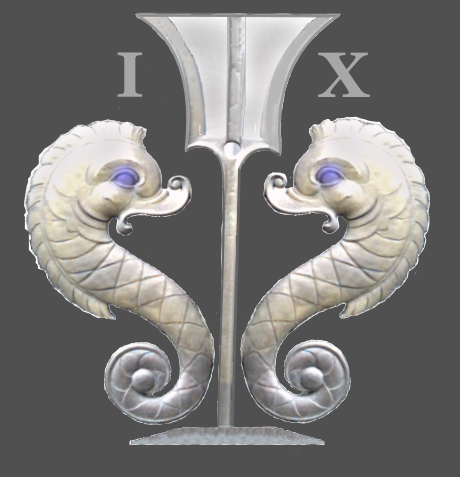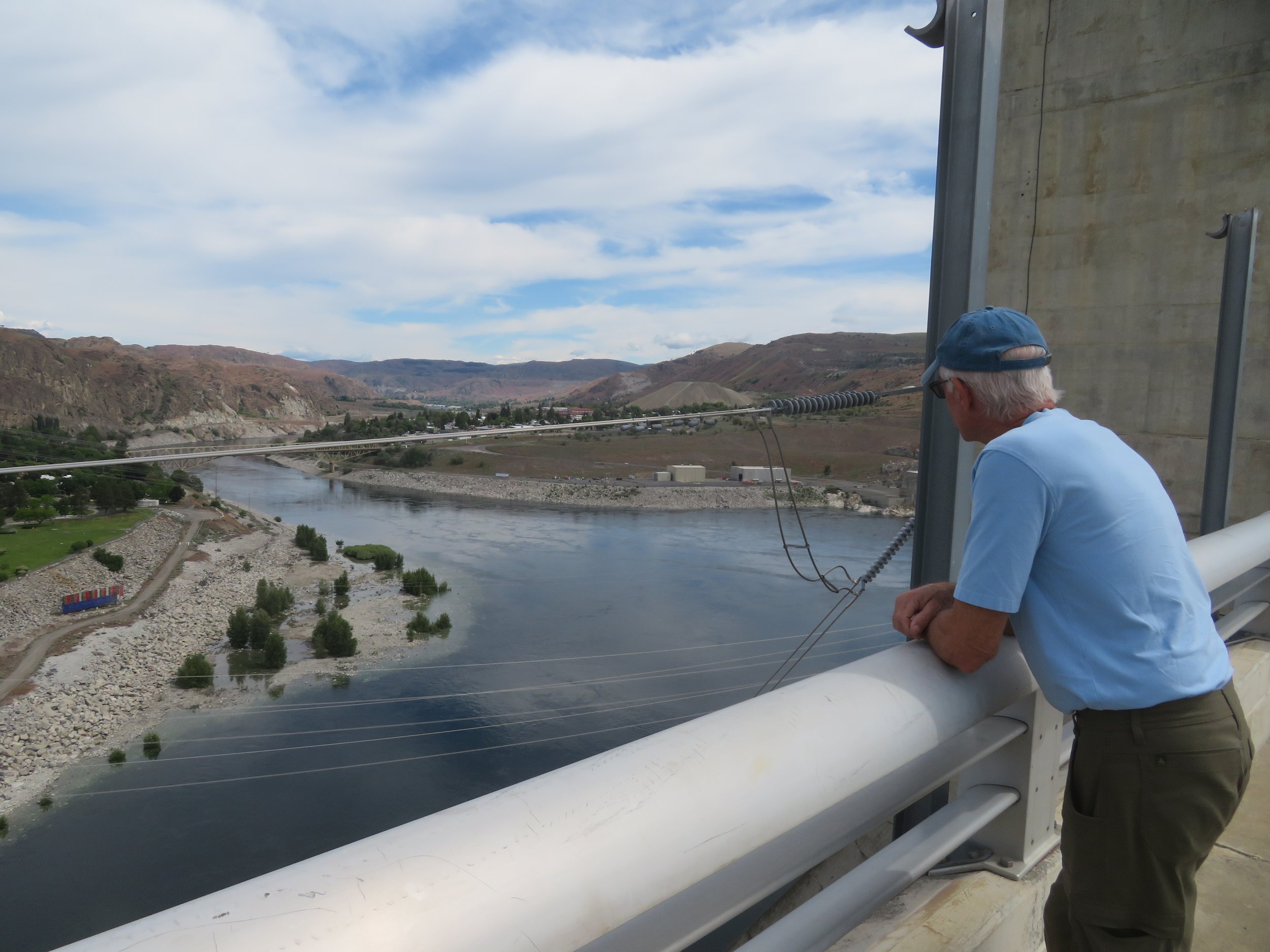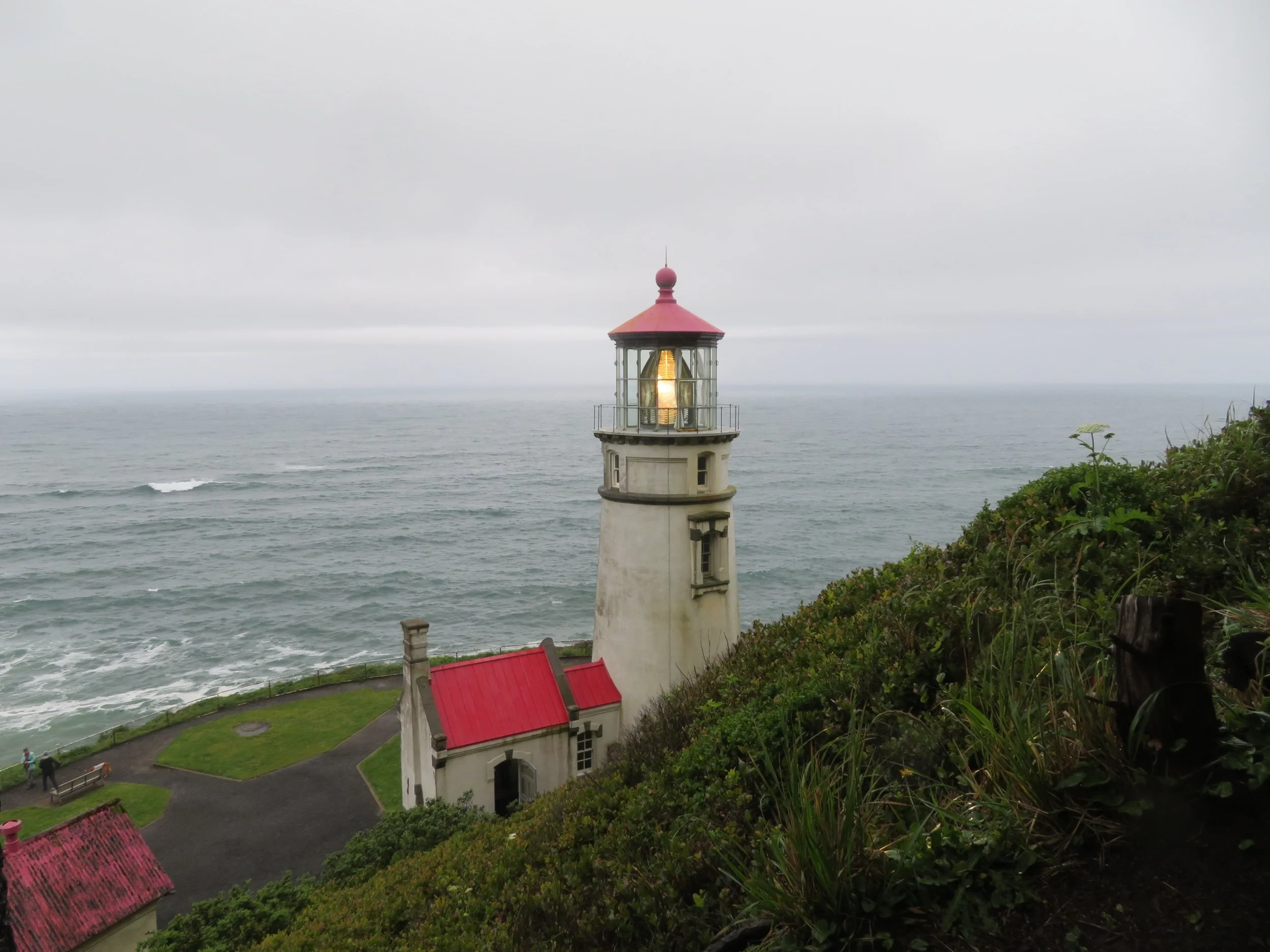“Where the Rails Meet the Sails of the Western Sea”
/“Where the Rails Meet the Sails of the Western Sea”
…the advertising motto of the Great Northern Railroad
Day 7 - We left the Midway RV Park at the civilized hour of 9AM, breakfasting at Judy’s, a local cafe, before departing. Something most unusual happened… the sun came out! It was short-lived before the clouds took over, but most appreciated. We’ve been on the road a week already and we’re about to reach the western terminus of the Great Northern Auto Trail aka US-2 today. We’re kind of pumped.
A week on the road and we’ve already changed our minds about the route at least a dozen times. Major changes included nixing our plan to continue up the Oregon coast to Olympic National Park to bike the Olympic Discovery Trail. The forecast of a week’s rain literally dampened our enthusiasm on that plan. Then we thought we’d visit Mount St. Helen’s Volcanic National Monument and/or Mt. Rainer National Park, but rain was forecast there, too, plus we were getting antsy to get to the Great Northern. My broken iPhone screen had us traveling through Portland for the repair instead of heading to the northernmost port in Oregon. We decided in the end we’d be okay to do less sightseeing prior to the Great Northern route and just get on the road. No disappointment, no regret… we were anxious to get the party started. We’re well-adapted to changes in plans.
Surprisingly, we sailed through the legendary Seattle traffic on I-5 in the HOV lane with nary a delay and headed to Everett, home of Boeing Aircraft, though we didn’t stop by to say hello. We exited I-5 at Hewitt Ave and drove to the waterfront, then turned around and followed the road to the very beginning of US-2 East. There’s no marker or anything to note it, other than the route sign.
Our first stop was a skip off 2E to the historic center of Snohomish. The old US2-E went through the town, but a new and improved four-lane US-2E sails right past it. It’s a cute little town, bustling with lots of shops and restaurants. We passed through, waved hi and returned to US-2. Cottonwood fluff has been dancing in the wind and blowing around like big fluffy snowflakes. Cottonwood…okay, but ix-nay on the snow.
We stopped for a picnic lunch at a tiny chapel/rest area between the towns of Monroe and Sultan on the north side of the highway. Though tiny, it had a couple pews and a pulpit with a Bible inside. A few loose dollars lay on one of the seats encouraging folks to take what they needed or give what they could.
The green fields and rolling hills we’d been seeing since we left Snohomish abruptly morphed into alpine terrain. The western Cascades loomed ahead. Snow-covered and cloaked in thick gray clouds, they looked a bit ominous.
We passed through Gold Bar and took a slight detour a mile north to the tiny mountain town of Index. There isn’t much there… a general store, a volunteer fire department, some houses and a town hall, but it looked pleasant enough. The ‘town wall’, a vertical granite wall behind the town, is considered a challenge for rock climbers to scale. We passed on this rare opportunity.
We also noted that the Pacific Northwest is an outstanding place to grow moss. A local confirmed he had just parked his car here last week.
We did, however, stop at Deception Falls for a quick hike, a look at the falls and to check out a very interesting roadside exhibit about the Great Northern Railroad, the railroad for which this US-2 auto trail is named. The thundering roar of the river was evident as soon as we stepped out of Blanche.
The hike was cold and raw, at first along a paved path, then onto a muddy, mossy trail through thick forest. Some of the path has been reclaimed by the river’s high waters and some of it had just deteriorated along with the bridges that cross it.
We finally made our way to Deception Falls and what a show. The spring run-off was in full force and the water was a white torrent, raging, roaring and roiling, throwing off spray and thick mist as it surged down the rocky riverbed and plummeted over the falls.
A few miles up the road the Iron Goat Interpretive Site provided more info on the Great Northern and also access to the Iron Goat Trail which leads to Steven’s Pass via the old railroad line which has been converted to a walking path.
As we climbed and climbed to the summit of Stevens Pass, it was dark, gloomy, cold and wet. Drizzle covered the windshield. In the distance, however, we spotted the tiniest patch of blue sky through a cleft in the mountain peaks.
As we descended to the east side of the pass, the sky began to lighten and the temperature rose dramatically. The sun was out!
The Wenatchee River was traveling along side us… all rapids and white water.
We traveled seven miles along the Icicle River up the Icicle River Road to Eight Mile Campground (go figure). Kayakers in wetsuits were plying the river. I shivered just thinking about it.
The campground was busy, but Ed, the camp host, found us an empty site that was level, spacious and quite pleasant with a picnic table, fire ring and a reasonably clean vault toilet just down the road. By dinner time, it was so cold and raw, we heated soup on the Coleman and ate it in the van.
Day 8 - It was even colder through the night and in the morning, we dawdled until it began to warm up a bit. The city of Leavenworth was nearby. This is a town that totally reinvented itself after years of decline as a railroad and timber town. It took advantage of its alpine location and ‘went Bavarian’, in the words of its brochure.
The town is totally dedicated to maintaining the Bavarian theme, from the font on its business signs (even Starbucks and Subway) to its summer stock Sound of Music production. There’s a Bavarian pastry shop and chalet-style motels. Some of the streets are ‘strasses’. Waiters in lederhosen serve at the local beer garden. There’s a nutcracker museum and fräulein cutouts stand on street corners welcoming you to town. Judging from the number of tourists milling about, I’d say the town’s transformation has been quite successful.
Next along the route was Cashmere, a neat little town in the heart of the Wenatchee Valley, ringed by mountains. Its claim to fame is the Aplets and Cotlets factory store in the center of town.
Since 1920 when two Armenian immigrants used a traditional lokum recipe from the ‘old country’ to create a candy confection similar to Turkish delight using locally grown apples and apricots, aplets and cotlets have been local favorites. The factory offers free tours and samples at their factory/showroom/store.
Orchards and vineyards line the highway roadside. We stopped in Wenatchee, ‘Apple Capital of the World’ so that David could repair Blanche’s leaking roof vent. We missed their Apple Blossom Festival in April which would have been fun. Vent repaired, we thought we’d visit the Washington Apple Commission Visitor Center, but it was closed.
David had sussed out a campground for the night, but by late afternoon when we spotted Coulee City Park and Campground, we decided not to go any further. On the shores of Banks Lake, we found a lovely spot in a grassy area with a concrete picnic table, fire ring and water spigot and clean flush toilets. The cost of $20/night for dry camping (no electric) was reasonable, although we thought 25¢/90-second shower was a bit odd.
Ubiquitous Canada geese were in residence with dozens of goslings and the requisite goose poop reflected the size of the population. The campground was nearly empty except for the geese and a couple of annoying seagulls that we had to fend off as we attempted to grill and eat our salmon dinner without sharing.
Day 9 - After a short morning walk, we decided on a side trip on WA-155 to visit the Grand Coulee Dam. As we headed north with Banks Lake on our west side, we traveled through the Moses Coulee, with 200-300’ brown, flat-topped cliffs rising up along side us.
Omak Mountain looms far in the distance.
We stretched our legs in Electric City at the Banks Lake Park to check out the Gehrke Windmill Garden. Emil Gehrke, a millwright by trade, began making windmills from scrap in 1965. He and his wife traveled 62,000 miles picking up discarded materials to create over 500 windmills, whirligigs and merry-go-rounds which originally adorned the yard of their Grand Coulee home. The windmill paddles are made from everything imaginable… coffee pots, cookie tins, heating duct vents, shovels and old farm machinery parts. Emil died in 1979, but his legacy lives on. Now considered American Folk Art, part of the collection resides here in the park, but other pieces are on display throughout the country.
On to Grand Coulee Dam, one of the largest concrete structures in the world. The dam contains 12 million cubic yards of concrete to corral the waters of the Columbia River. Built in 1933-1941 as one of Roosevelt’s New Deal projects, the dam delivers 21 billion kw-hours of electricity each year to eight western states and Canada. It’s pretty dam impressive. Interestingly, its main purpose is not power generation nor flood control, but rather to supply an agricultural irrigation system to the Columbia Basin.
We took a free one-hour tour of the dam, descending via elevator into one of the pumping stations for a look-see and then driving across part of the dam to view the spillways.
We lunched in a grassy park in the shadow of the dam, then headed down WA-174 to rejoin US-2. The weather had warmed to the mid-70s, the sun was shining and the sky was a pale baby blue. On summer evenings, there is a laser light show that is projected onto the dam wall which we unfortunately missed.
We passed vast green fields occasionally interrupted by a bright yellow field with blossoming canola flowers. This area was traditionally dry-farming land, but the irrigation waters provided by the Grand Coulee Dam have made it fertile and productive.
We enjoy passing through little towns along the way. Their welcome signs many times reflect the personality of the town. We especially liked Wilbur, Washington on US-2, west of Spokane for its Charlotte’s Web theme.
We hung a right turn at Spokane and since we’d spent time here before, simply headed north. Our destination for the evening was the Pend Oreille (Pen-doray) County Campground. At first glance as we drove along the rutted dirt entry road, we figured we’d made a poor choice. Most sites weren’t level, picnic tables were decrepit and falling apart, water spigots weren’t working… blah, blah, blah. But upon further exploration, we changed our minds. Some of the sites were level and quite lovely, nestled under 150’ tall red cedars. There was ample free firewood and lots of birdsong. The vault toilet was close and clean with a working fresh water pump nearby. There were some newer picnic tables and campfires were allowed in the rock fire rings. And, oh yeah, we were the only campers in the entire campground.
We spotted a pileated woodpecker, a new species for us, working hard on extracting something good from a tree trunk, so hard, in fact, he didn’t even notice we were there.
By the way, Miriam is traveling with us again. Remember her… the mousekin who adopted us back in Taos, New Mexico back in 2020? She’s a quiet mouse, doesn’t eat much, doesn’t leave cheese or cracker crumbs laying around and she certainly doesn’t take up much room.
We’re hoping lots of you are traveling with us on this trip. If you are traveling along, please let us know. We love the company. A shout-out to longtime friend, Susan from California… glad to have you as our traveling companion. More next time as we continue east… Come on along!








































